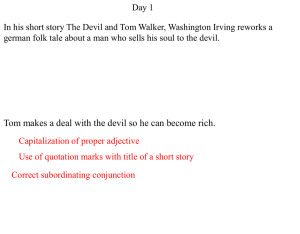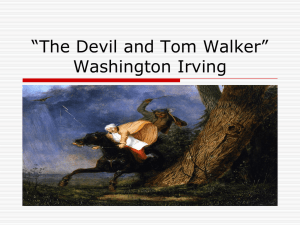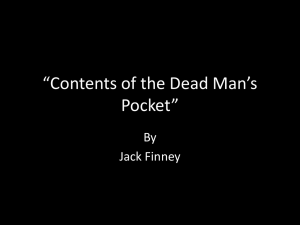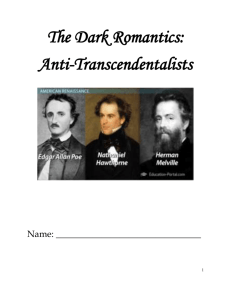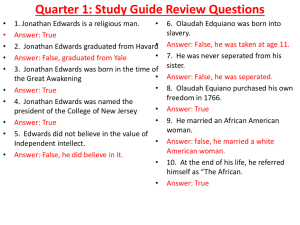Literary analysis papers
advertisement
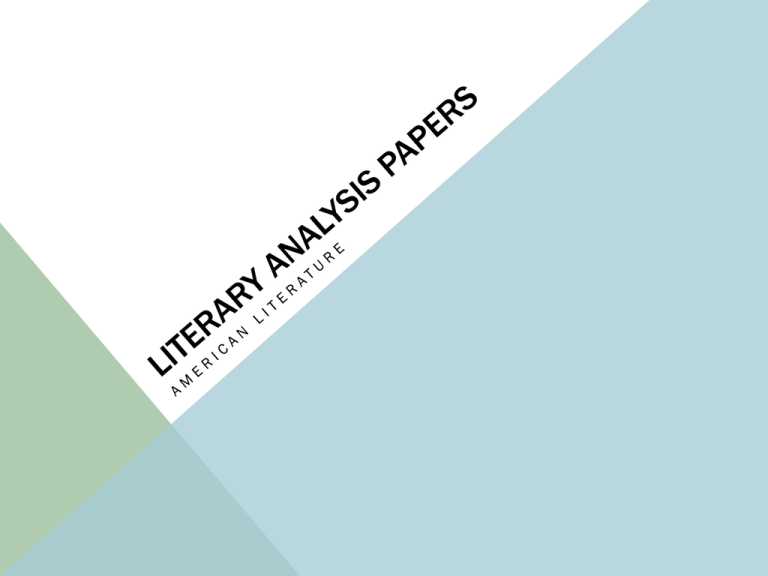
FIRST STEP Read and annotate the text. Be sure that you understand not just the plot, but also the other elements of the story like character, setting, symbolism, and theme. CREATING THE THESIS This sentence is usually placed as the last sentence of your introduction. It must be specific. It must be detailed. Bad: “The Devil and Tom Walker” contains many themes. Good: “The Devil and Tom Walker” uses symbolism to show that humans are inherently corrupt. Best: In “The Devil and Tom Walker,” Irving illustrates human corruption through the use of the woods as setting and symbolism. ##Use the given thesis statement to make a clearer and more specific one you can use in your assigned paper. CREATING SUPPORT The next step is to ensure that you have enough support to prove your thesis. Usually you should count on having at least three support (body) paragraphs. Determine what support you can use and turn these into three general sentences to prove your thesis. These will be the topic sentences of your corresponding paragraphs. Thesis: In “The Devil and Tom Walker,” Irving illustrates human corruption through the use of the woods as setting and symbolism. S1: The swampy, gloomy forest mirrors our the fact that our base human desires often lurk in our subconscious, waiting to overwhelm us. S2: The hollowed trees represent the innate internal corruption of man. S3: The names written on the trees symbolize that knowledge and/or life often corrupts our naïve view of the world, which leads us to a cynicism. ##Now complete the topic sentence boxes with general statements that you can support with textual evidence. SUPPORTING SUPPORT Your topic sentences must be proven using evidence from the text. You can pull quotes, you can paraphrase, or you can summarize. S2: The hollowed trees represent the innate internal corruption of man. Ex: The trees are described as “fair and flourishing without, but rotten to the core” (Irving 293). Ex: The trees mirror the people whose names were etched upon them because though those people are viewed positively in the community, they are actually corrupt. (I will support this with Deacon Peabody) Ex: Tom realizes that he belongs in this forest because of his hard and miserly ways, and he determines that he wants at least a good worldly life. ## Now use the boxes below the topic sentences to place your evidence. INTRODUCTION After you have determined how you plan to argue, you should focus on your introduction. In your introduction, the first time you mention the author, you must write his or her first and last name (middle if there is one). Afterwards, you refer to the author by last name only. Starting a paper with something like “Washington Irving wrote “The Devil and Tom Walker”” or “The Devil and Tom Walker was written in 1817 by Washington Irving.” is BORING!!!! Instead of boring your reader, you can do the following: Begin with a quote from the story or a quote that relates to the theme of the work. “For greed all nature is too little,” according to Lucius Seneca. In Washington Irving’s “The Devil and Tom Walker,” this sentiment is true. Begin with a question Is the devil responsible for leading man to Hell? Or is man responsible for his own demise? Begin with an interesting fact The woods are often used in American literature as a symbol of mystery and evil. INTRODUCTION (CONTINUED) Begin with an anecdote that relates to your thesis/theme A woman in Decatur, Georgia went on record to tell the story of how she lost her job, house, possessions and friends. Determined to be a millionaire by the time she was thirty, she made poor choices when it came to investments. The more money she made, the more money she spent. Until she was broke. Putting her savings into a bond that crashed last year when the Dow Average dropped, she lost everything. And having lost everything, she also lost her status. Soon her friends stopped calling and caring. Greed had finally triumphed in its destruction. In “The Devil and Tom Walker,” Tom’s destruction was not so obvious. … Begin with an analogy that relates Like gangrene, greed quietly corrupts from the inside to destroy the entire body. But instead of killing the body, greed often corrupts the soul. In “The Devil and Tom Walker,” INTRODUCTION (CONT) Once you know how you want to lead into the essay, you must be sure that everything flows to the thesis. Like gangrene, greed quietly corrupts from the inside to destroy the entire body. However, instead of corrupting the body, greed often putrefies the soul. In “The Devil and Tom Walker,” avarice ravages the soul of the titled character. Described as a miserly and hard-hearted man, Tom Walker seals his destruction by making a pact with the devil. When he decides that his actions are wrong and tries to turn to God, it is too late. He is so corrupt by his dealings with the devil that he is easily extinguished. His fate is mirrored by the setting of the story, which is primarily in a swampy , dark, and dank New England forest. In “The Devil and Tom Walker,” Washington Irving illustrates human corruption through the use of the woods as setting and symbolism. ##Now create your own introduction. LITERARY ANALYSIS BODY PARAGRAPHS 1. Begin with your topic sentence. 2. Your next sentence should serve as a bridge between your topic sentence and your evidence. (This will give the reader context.) 3. You must next state your evidence. (This will be a quote, paraphrase, or summary of events) 4. You must spend at least two sentences explaining your evidence. 5. Next you bridge to the following piece of evidence. (This bridge can be provided in the above explanation.) 6. You state your next piece of evidence. 7. You must spend at least two sentences explaining your evidence. 8. Next you bridge to the following piece of evidence. (This bridge can be provided in the above explanation.) 9. You state your next piece of evidence. 10. You must spend at least two sentences explaining your evidence. 11. Conclude AN EXAMPLE BODY PARAGRAPH The hollowed trees represent the innate internal corruption of man. As Tom happens upon the devil, he notices the condition of the surrounding trunks. The trees are described as “fair and flourishing without, but rotten to the core” (Irving 293). The trees having beautiful leaves , but being “rotten” on the inside reinforce that sometimes those people who seem good are really evil. It also shows that though greed can tend to one’s superficial needs such as his or her appearance and immediate surroundings, it cannot save one’s soul. The trees not only function as this reminder in their appearance due to the leaves, but they also reinforce the theme with the names on their trunks. In the text, the trees mirror the people whose names were etched upon them because though those people are viewed positively in the community, they are actually immoral. For example, Deacon Peabody was a prominent member of town, but according to the devil he needed to “look more to his own sins and less to those of his neighbors” (Irving 292). This warning means that though Deacon Peabody is a respected church-going man, he is damned because of his greedy dealings with the Native Americans and because he uses his position in the church to accuse others of sinning. The trees speak to the corruption of even the most seemingly devout. Tom Walker, however, knows he is already corrupt. As Tom looks around, he realizes that he belongs in this forest because of his hard and miserly ways, and he determines that he wants at least a good worldly life. Just like the trees, Tom is content to aesthetically “flourish.” He wants comfort and earthly happiness instead of eternal peace, which is why he makes a bargain with the devil. Tom is one of those trees just as any human could be. CREATE YOURS You should have three paragraphs similar to the one provided. Be sure to cite with author and page number, when you use a direct quotation or paraphrasing of the text. Place this in parentheses after the sentence. Place the period after. EX: For example, Deacon Peabody was a prominent member of town, but according to the devil he needed to “look more to his own sins and less to those of his neighbors” (Irving 292). All discussion should be in present tense!!! CONCLUSION This is the place where you need to relate the thesis and themes presented to the larger world. Place your argument (if you have not already) into the world at large. Do not introduce a new topic! It should restate (in different words) your thesis and summarize your main points. The woods as a symbol for a person’s capacity for evil and darkness is a common archetype. In “The Devil and Tom Walker” the reader sees this archetype unfurl through Tom’s demise. The internal corruption of the forest and trees represents mankind’s inherent internal corruption. For though we as humans often like to pretend that we are innocent, one can easily surmise through history that the true human heart is as dark as the hell where Tom Walker now roasts. REMINDERS You must have a bibliography (Works Cited) Go to www.easybib.com and hit the book tab. You must type a manual entry. Then choose a chapter or section. You must place parenthetical citations in the body of the paper. You must write in present tense. You must use quotation marks around titles of short stories and poems. You must have a title other than “The Devil and Tom Walker” Essay I would title my faux paper: The Devil Inside All papers must be typed and in MLA format.






